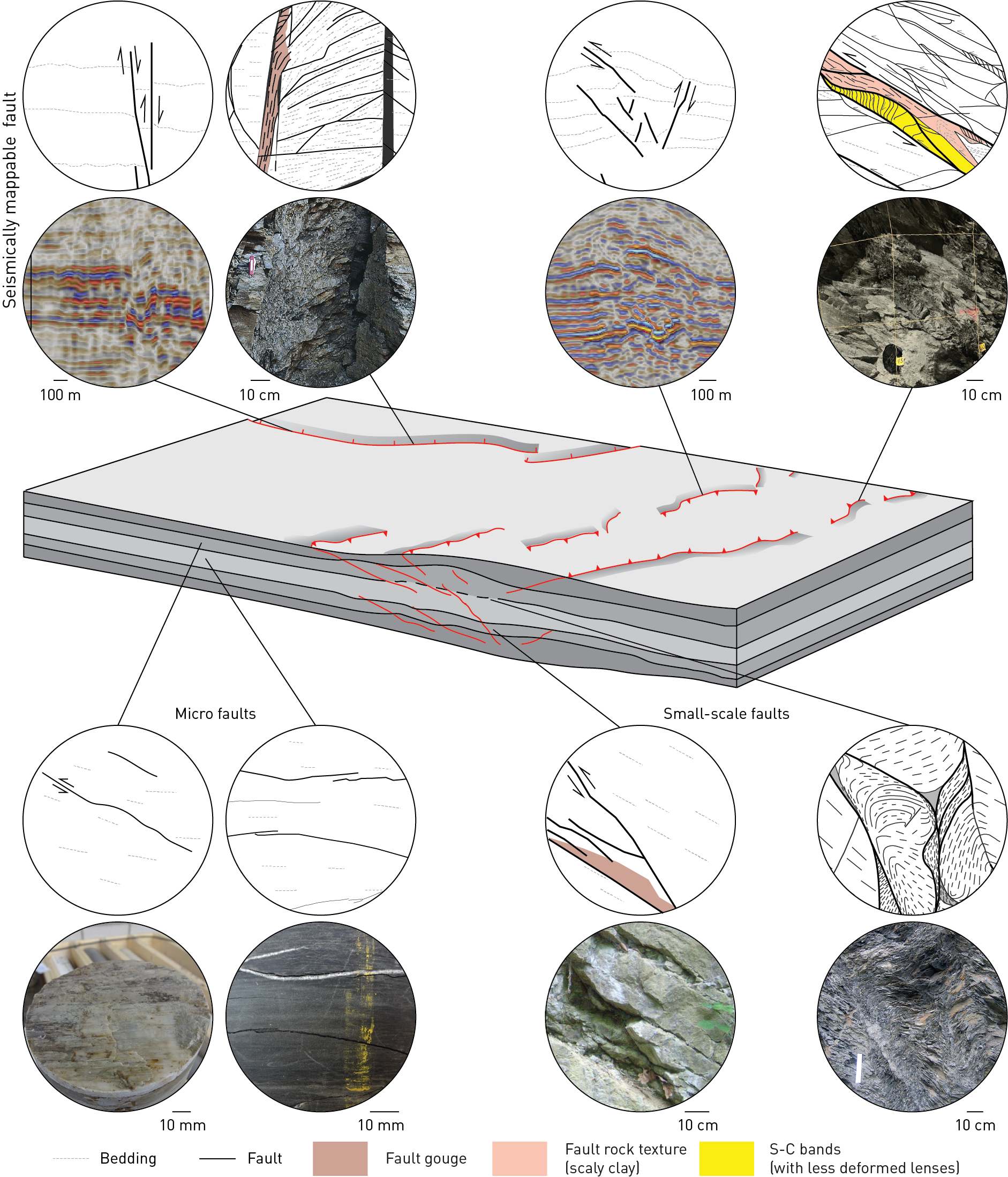Considering the different spatial scales of geological structures observed in the three siting regions, it is necessary to use a unifying terminology for a comparative analysis of the siting regions. For the sake of consistency with previous work carried out by Nagra, in this chapter the terminology originally employed for the description of structures recorded in the cores of the TBO boreholes is adapted (Tab. 2‑1).
Generally, a distinction is made between Mohr-Coulomb brittle failure and ductile deformation. Stylolites, shear zones and mylonites as defined in Ebert & Decker (2019) were identified as ductile structures. The Mohr-Coulomb brittle failure structures are called fractures as an overarching term. Extensional fractures are called joints; these may be barren or veins when filled. The term fault refers to fractures that have experienced shearing detectable on the scale of observation (e.g. in hand specimens). To better convey the variable dimension covered by the term fault, faults were subdivided according to their size into regional fault zones, local faults, small-scale faults and micro faults (Fig. 4‑53). The structural terminology used in this report is summarised in Tab. 4‑1.
Tab. 4‑1:Summary of the structural terminology for faults across the observation scales
|
Tectonic structure |
Definition |
Dimensions |
|---|---|---|
|
Regional tectonic elements |
Regional tectonic element is an overarching term encompassing (i) regional fault zones and (ii) zones of increased tectonic complexity. |
km-scale length |
|
Regional fault zone |
Regional fault zones encompass seismically mappable, relatively closely spaced and clustered faults in the Mesozoic strata associated with established Northern Switzerland tectonic elements. |
km-scale length Displacement is variable among the structures and dependent on structural style (typically 10 m to 10s of metres) |
|
Zones of increased tectonic complexity |
Overarching term including (a) zones characterised by an increased number of local faults mapped in seismic reflection data, but devoid of a distinct regional trend, (b) zones with diffuse deformation linked to a regional fault zone and (c) structural setting known to bear the potential for increased sub-seismic deformation, e.g. in connection with major regional basement structures. |
km-scale length |
|
Local fault |
Seismically mappable faults or faults identified in outcrops that are solitary structures and are not part of the regional fault system. |
100s of metres scale length Displacement is dependent on structural style (typically m to few 10s of m) |
|
Seismically mappable fault |
Seismically mappable faults are faults matching the criteria defined by a number of fault diagnostic signatures in seismic reflection data (Nagra 2024a, 2024b, 2024c). |
Faults with vertical offset > 5 – 10 m can be detected consistently in the central part of the three siting regions. In many cases, also smaller features can be detected by 3D seismic reflection data |
|
Sub-seismic faults |
Faults that are too small to be detected by faulting diagnostic signatures in seismic reflection data. |
Maximum vertical offset of subseismic fault is < 10 m in the central part of the three siting regions. In many cases, also smaller features can be detected by 3D seismic reflection data (Nagra 2024a, 2024b, 2024c) |
|
Small-scale fault |
A small-scale fault is a complex planar structural discontinuity with a significant width that is characterised by displacement and shear indicators. A small-scale fault is further characterised by (i) the occurrence of multiple structures, (ii) different structure types (e.g. micro faults or veins) and / or (iii) the formation of fault rock (clay gouge, cataclasite, dilation breccia etc.). |
10s of metres to few m estimated length Displacement dependent on structural style (typically cm to m) |
|
Micro fault |
Plane of shear failure, i.e. slickensides with evidence for plane-parallel movement. A micro fault is a single, thin, planar and sharp structural discontinuity with negligible volume. Micro faults show shear indications such as different types of striation. |
< few m estimated length Measured displacement is dependent on structural style (typically mm to a few cm) |
|
Joint |
A barren, closed fracture on which there is no measurable slip or dilation at the scale of observation (Hancock 1985). |
< few m estimated length |
|
Vein |
Mineral infill of a fracture with a dilatational component. |
< few m estimated length |
|
Fracture |
General term for any type of Mohr-Coulomb failure, i.e. it is applicable to structures formed by extension or shear. Fractures include approximately planar discontinuities such as faults, joints and veins (Peacock et al. 2016). |
< few m estimated length |
|
Stylolite |
Irregular, commonly jagged surface in a rock formed by local removal of material by pressure solution (Passchier & Trouw 1998). |
< few m estimated length |

Fig. 4‑53:Conceptual block diagram showing fault terminology across the observation scales
Note the mechanical stratigraphy indicated by the grey shading and the highly segmented faults. The seismically mappable normal fault represents the Neuhausen Fault with outcrop in Siblingen. The seismically mappable reverse fault is the Baden – Irchel – Herdern Lineament and the "Main Fault" in the Mont Terri rock laboratory as an outcrop example (modified after Jaeggi et al. 2017).

